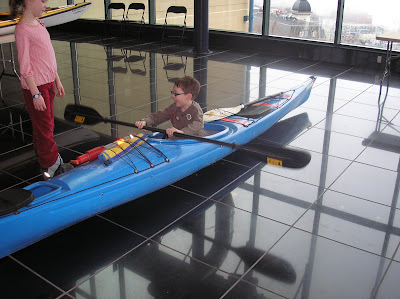

Sometime ago I stumbled onto a website entitled Roll or Die. It seemed an interesting title for a kayaking destination. However, here many of us subscribe to a
Roll Otherwise It is a Nuisance(because we have to rescue you) approach. We like to give each other more options, since having the skill is severely put to the test when or if, you are upended into breathtaking bitter cold of the North Atlantic. To this end we have spent as many hours in the pool as possible - developing and honing skills in bracing and rolling.
Last night was a special event for the club where we assembled six experts and they instructed, critiqued and advised participants in a "workshop" format.
Rolling is a counterintuitive skill. As Bob Gagnon put it: you are fighting evolution. Since in almost every situations where we fall, and attempt to right ourselves > the head leads. This is also a neurophysiological reflex as I recall it -so we are in fact, trying to override a reflexive reaction.
We are actually training the head to follow the blade of the paddle and lag slightly behind until the hip and knee are driven up towards thigh brace and the back extends over the rear deck.
Apparently I still have highly tuned survival righting reflexes - that combined with some lumbar stiffness means I essentially manipulate my lower back and neck every time I do a roll. This is why the club sponsored a yoga session in December - in the hope that members had enough time to implement an agility and flexibility program that would allow them to do these manoeuvres. And here is the other thing - everyone thinks they are doing a full extension. The sense of where the body is, is often described as
kinesthetic awareness. Sometimes this is skewed in our own minds. So these sessions are invaluable, provided you are paired with instructors who provide honest feedback. Thankfully KNL is blessed with numerous honest instructors. As a coach in another sport - technical analysis is critical at a certain phase. I would put some of us in the refinement category - so I was grateful to skilled feedback on what was going right and areas needing improvement.
The other aspect to successful rolling is to remember there is a significant mental skill component: visualizing the technique beforehand, repeating the arc of the shoulder punch and sweep, rotation of the trunk and the final lay back. I sometimes feel like a free style skier at the top of the hill. Same concept works though - visualization of the technique. To achieve the hip flick Bob recommended a walking exercise that appears like you are stepping on hot coals with hips rotated out. Of course, once upside down the other key is to relax and focus. Depending on your underwater experiences being upside down can be unnerving - so working on this aspect of training is another good reason for pool training. When cued by instructors not to rush, I have to remind myself what this means. It is harder than one would think. What is only 5 seconds can seem like 5 minutes.
One major element I am taking away from the clinic - hold onto the paddle with my lead hand with only two fingers. This is to cue myself not to power down with the blade. It works, for me.
Pool clinics are a great learning opportunity - this one was no exception. As with some many sports related training there is ultimately only one way of achieving
success - practice.












